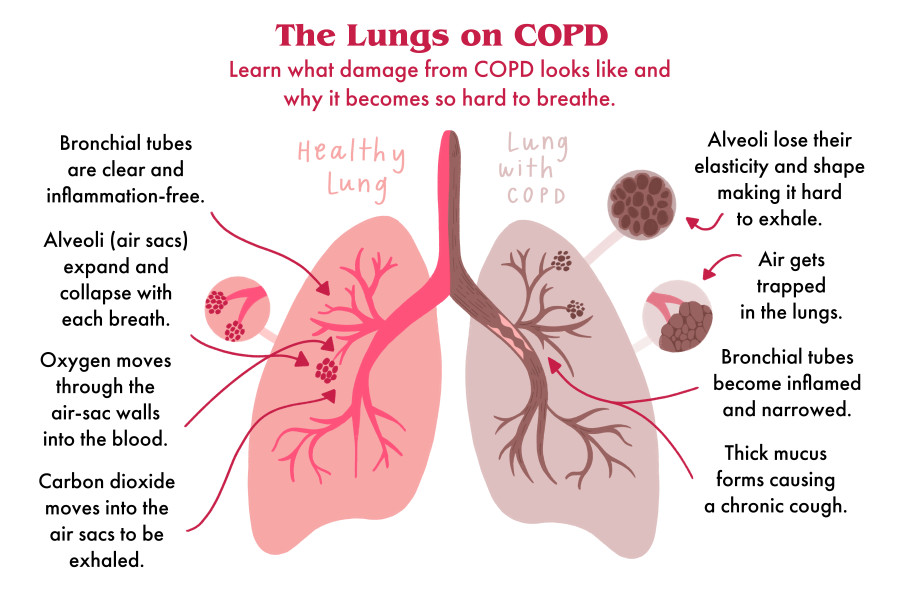The job of our lungs is to take oxygen from the environment and transfer it into the bloodstream. Lungs are located behind our ribcage in the chest on either side of the heart. Although they come as a pair, the left and right lungs are different sizes. The left lung is slightly smaller to make room for our heart
For us to breathe properly, our lungs need help from the muscles surrounding them. For example, the diaphragm, abdomen muscles, and sometimes our neck muscles help us take deep breaths. When something prevents our lungs from working correctly, lung disease may arise.
In this article, I will be listing, discussing, and describing four of the most common diseases that invade our lungs.
ASTHMA
Asthma is a long-term lung disease that most commonly affects children, but adults experience it as well. The condition involves narrowing airways and extra mucus production which results in increased difficulty breathing.
It causes wheezing, coughing, breathlessness, and chest tightness. Asthma tends to act up late at night or early in the morning whenever something in your environment bothers your lungs. Although it acts up at certain times of the day, you have asthma all the time.
When asthma begins to significantly act up, this is referred to as an asthma attack. An asthma attack occurs when you’re exposed to an allergy trigger. Everyone’s asthmatic triggers vary greatly.

What causes an asthma attack in you, may not affect someone else at all. An attack includes coughing, wheezing, and trouble breathing. The lungs’ airways begin to swell and prevent air from successfully filling the lungs. Common asthma triggers include tobacco smoke, pets, mold, dust, firewood, air pollution, etc.
Asthma can spread genetically and currently has no cure, but there’s plenty of medication to help control and prevent attacks. There are six types of asthma: adult-onset, allergic, asthma-COPD overlap, exercise-induced bronchoconstriction, non-allergic asthma, and occupational asthma.
LUNG CANCER
Cancer is an unfortunate disease that affects the patient and has a way of emotionally damaging the patient’s family. When the cells in our body grow out of control, cancer is most likely the culprit. Lung cancers tend to be placed into two groups: small cells and non-small cells.
Small cell lung cancer is more aggressive than its counterpart. It spreads quickly and most of those diagnosed have a history of smoking. The symptoms of small cell and non-small cell are very similar, but one is more aggressive. Lung cancer, in general, is the leading cause of cancer deaths and is the second most diagnosed in both men and women.
As previously stated, the symptoms of small and non-small cell lung cancer are very similar. Some of these symptoms include fatigue, a hoarse voice, persistent cough, appetite loss, difficulty swallowing, shortness of breath, blood in the mucus from coughing, swelling of the neck and face veins, and chest pain and discomfort. Quite the symptom list, right? Someone suffering from lung cancer is more likely to notice these symptoms once their cancer has reached a later stage.
COPD
Chronic obstructive pulmonary disease, also known as COPD, is a chronic inflammatory lung disease that obstructs airflow to the lungs. Like the previous lung diseases mentioned, COPD makes breathing difficult, increases mucus production, and causes wheezing.
This condition can be caused by irritating smoke/gasses like cigarette smoke. Those who suffer from this have a higher chance of developing heart disease and lung cancer.
COPD is usually accompanied by a group of lung diseases. Most commonly, COPD is made up of emphysema and chronic bronchitis. Unfortunately, those two conditions tend to occur together and increase the severity of COPD.

Lung damage caused by COPD is permanent and gets worse over time. Like asthma, COPD doesn’t currently have a cure, but there are many treatments to lessen the symptoms caused.
Unlike lung cancer, only some chronic smokers are diagnosed with COPD even though many long-term smokers have less lung function. COPD causes our bronchial tubes to lose elasticity and forces them to over-expand and stay that way. These over-expanded tubes cause air to be trapped in the lung when exhaling.
PNEUMOTHORAX (COLLAPSED LUNG)
Hearing that you have a collapsed lung can be very terrifying, but what exactly is a collapsed lung? Pneumothorax happens when air leaks into the space between our lungs and chest wall. The air then pushes the outside of the lung causing the whole organ or just a portion of it to collapse.
This condition can be caused by blunt force trauma to the chest, other lung diseases, chest/abdomen surgery, or a blocked airway. The severity depends on the size of the affected area. If only a small portion of the lung is in trouble, you may have no symptoms.
If a large area of the lung is affected you’ll feel quite a few of the symptoms. There are two main symptoms of pneumothorax: chest pain and shortness of breath. If the pain progresses to an unbearable amount, seek medical attention immediately. Luckily, Specialty Care Clinics has a pulmonology doctor ready to take action when needed.
Men are more likely to experience a collapsed lung than women and it occurs in the 20-40 year age group. Some risk factors for the condition are smoking, genetics, and previous pneumothorax. Treatment usually involves sticking a needle or chest tube between the ribs to get rid of the excess air build-up in the chest cavity.
Collapsed lung (pneumothorax)
If you’re experiencing any severe chest pain or difficulty breathing, don’t wait for it to pass on its own. Our team here at Specialty Care Clinics strives to improve our patients’ lives and prevent their suffering. Your health matters.
Call us today at 469-545-9983 to book an appointment with our expert lung specialists.
